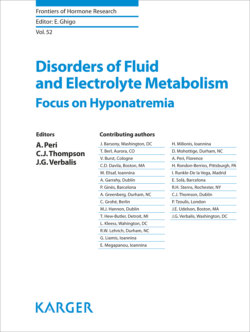Читать книгу Disorders of Fluid and Electrolyte Metabolism - Группа авторов - Страница 25
На сайте Литреса книга снята с продажи.
Vasopressin
ОглавлениеVasopressin is a nine-amino acid polypeptide hormone with a wide array of biological functions, most importantly water balance and vascular tone. Vasopressin is synthetized in the magnocellular neurons of the paraventricular and supraoptic nuclei located in the hypothalamus. Vasopressin production is encoded, along with 2 associated proteins, neurophysin II and copeptin, by the vasopressin gene. Vasopressin is synthesized as a prohormone, prepro vasopressin, and then transported axonally in the stalk to the posterior pituitary where it is stored for secretion. On the way to the posterior pituitary, prepro vasopressin is processed into the active hormone by enzymatic cleavage into the three conforming peptides: neurophysin II, vasopressin, and copeptin [11]. These peptides are released into the circulation in equal ratios. Vasopressin binds to V1, V2, and V3 receptors. V1 receptors are expressed in the vascular smooth muscle, myometrium, and platelets. V3 receptors in the pituitary, and V2 receptors (V2R) in the basolateral membrane of cells of the thick ascending limb of the loop of Henle (TALLH), distal convoluted tubule (DCT), connecting tubule (CNT), and collecting duct (CD). V2R in CNT and CD regulates trafficking of aquaporin 2 (AQP2) and hence water permeability. V2R present in TALLH and inner medullary CD regulate the activity of the Na+:K+:2Cl- cotransporter (NKCC2) and urea transporter UTA1, respectively, and hence the delivery of solutes to and generation of hypertonicity in the medulla. V2R is also expressed in the DCT where it regulates the expression of the Na+:Cl- cotransporter (NCC), and in the vascular endothelium where its activation is responsible for the secretion of von Willebrand factor. V2R-mediates AQP2 trafficking and expression signals via G protein (Gs protein). Binding of vasopressin to V2R activates adenylate cyclase, increasing intracellular cAMP levels, activating protein kinase A, and leading to the translocation of vesicles containing AQP2 into the apical membrane and increasing tubular permeability to water. In addition to the short-term regulation of AQP2 membrane targeting, long-term exposure to vasopressin increases AQP2 gene expression and protein abundance [10].
